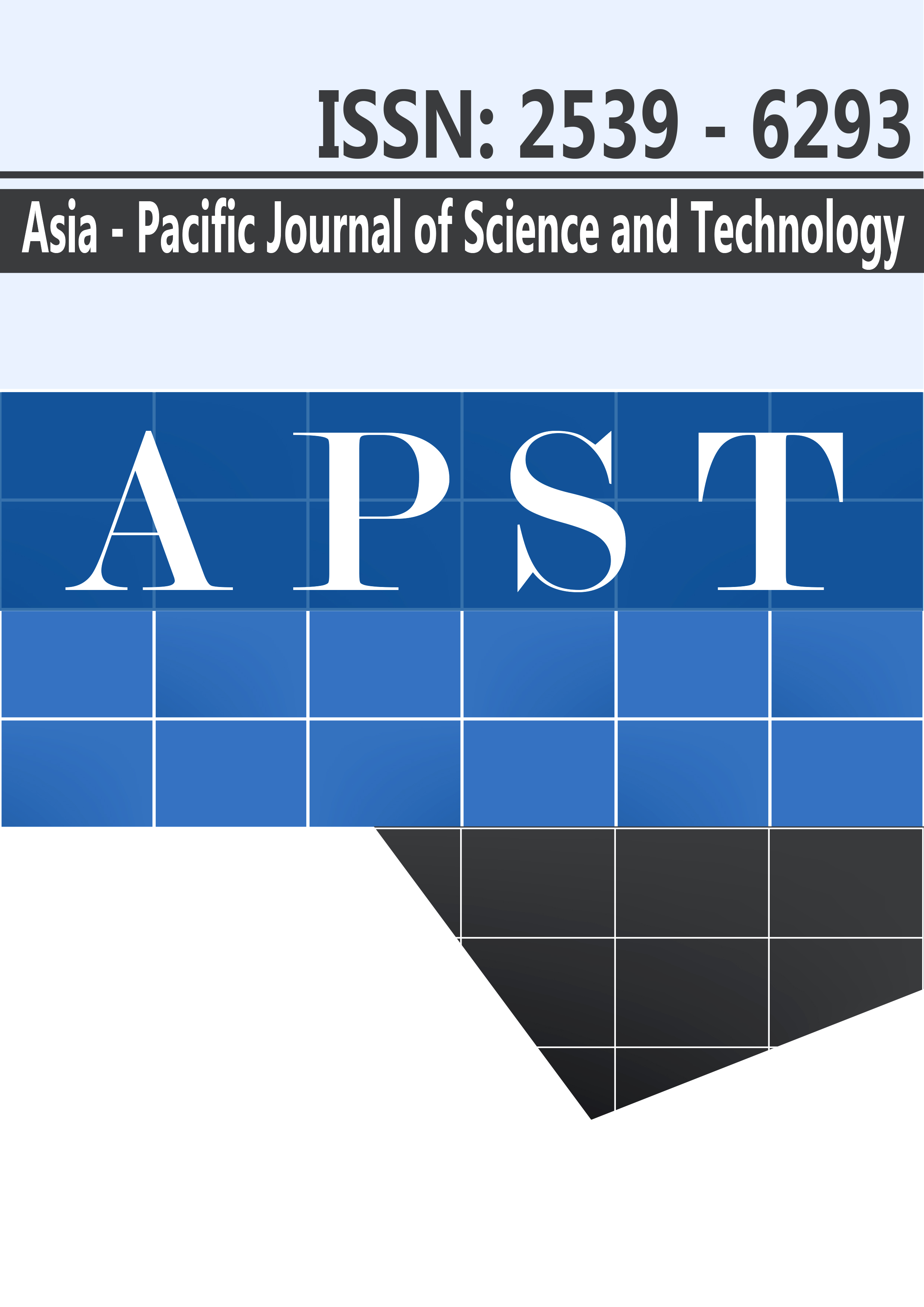SARIMA intervention based forecast model for visitor arrivals to Chiang Mai, Thailand
Main Article Content
Abstract
The purpose of this research is to implement the forecast model for domestic and international visitor arrivals to Chiang Mai, Thailand using seasonal autoregressive integrated moving average (SARIMA) with intervention analysis. The ADF and extended HEGY tests for the unit root identify that the observed time series are regular and seasonal non-stationary. After differencing of log transformation to the series, the SARIMA model is formulated using monthly data 2000-2007 for the pre-intervention. The residuals obtained from the forecast and secondary data 2008-2013 are assessed with the prior knowledge of various significant crisis events to identify the intervention functions in the forecast model. From the analysis, the violent political turmoil is the major long-term adverse impact on the visitors, whereas the influx of Chinese visitors helps to increase the number of international visitors. The forecasting performance comparison evaluated in terms of the accuracy and reliability indicates that the proposed forecast model outperforms the other existing models for the out-of-sample forecasts. Furthermore, if the government intensifies for solving the internal politics while the provincial administrator can maintain the massive number of Chinese, Chiang Mai will welcome over 10 million visitors and will also generate tourism revenue of about USD 2,400 million in 2018 estimated from the proposed forecast model.
Article Details
References
[2] Athanasopoulos, G., de Silva, J., 2012. Multivariate exponential smoothing for forecasting tourist arrivals. Journal of Travel Research 51, 640-652.
[3] Bangwayo-Skeete, P.F., Skeet, R.W., 2015. Can Google data improve the forecasting performance of tourist arrivals? Mixed-data sampling approach. Tourism Management 46, 454-464.
[4] Burger, C., Dohnal, M., Kathrada, M., Law, R., 2001. A practitioners guide to time series method for tourism demand forecasting - a case study of Durban, South Africa. Tourism Management 22, 403-409.
[5] Chen, K. Y., Wang, C.H., 2007. Support vector regression with genetic algorithms in forecasting tourism demand. Tourism Management 28, 215-226.
[6] Preez, J., Witt, S.F., 2003. Univariate versus multivariate time series forecasting: an application to international tourism demand. International Journal of Forecasting 19, 435-451.
[7] Cankurt, S., Subasi, A., 2012. Comparison of linear regression and neural network models forecasting tourist arrivals to Turkey. 3rd Int. Symp. On Sustainable Development, Sarjevo, p. 304-311.
[8] Wongsathan, R., Jaroenwiriyapap, W., 2016. A hybrid ARIMA and RBF Neural network model for visitor quantity forecasting: A case study for Chiangmai Province. KKU Research Journal 21, 37-54.
[9] Chaitip, P., Chaiboonsri, C., Mukhjang, R., 2008. Time series models for forecasting international visitor arrivals to Thailand. Int. Conf. on Applied Economics-ICOAE 2008, Kastoria, Greece, p. 159-163.
[10] Nanthakumar, L., Ibrahim, Y., 2010. Forecasting international tourism demand in Malaysia using Box Jenkins SARIMA application. South Asian Journal of Tourism and Heritage 3, 50-60.
[11] Haridev Singh E., 2013. Forecasting Visitor Inflow in Bhutan using Seasonal ARIMA. International Journal of Science and Research (IJSR) 2, 242-245.
[12] Shu, M.H., Hung, W.J., Nguyen, T.L., Hsu, B.M., Lu, C., 2014. Forecasting with Fourier residual modified ARIMA model-An empirical case of inbound tourism demand in New Zealand. WSEAS Transaction on Mathematics 13, 12-21.
[13] Baldigara, T., Mamula, M., 2015. Modelling International Tourism Demand using Seasonal ARIMA Models, Tourism and Hospitality Management 21, 19-31.
[14] Jackman, M., Greenidge, K., 2010. Modelling and forecasting tourist flows to Barbados using structural time series models. Tourism and Hospitality Research 10, 1-13.
[15] Box, G.E.P., Tiao, G.C., 1975. Intervention analysis with applications to economic and environmental problem. Journal of the American statistical association 70, 70-79.
[16] Min, J.C.H, Lim, C., Kung, H.H., 2001. Intervention Analysis of SARS on Japanese Tourism Demand for Taiwan. Quality and Quantity 45, 91-102.
[17] Min, J.C.H, Lim, C., Kung, H.H., 2010. Intervention Affecting AIR Transport Passenger Demand in Taiwan. African Journal of Business Management 4, 2121-2131.
[18] Goh R., Law, R., 2002. Modeling and forecasting tourism demand for arrivals with stochastic nonstationary seasonality and intervention. Tourism Management 23, 499-510.
[19] Untong, A., 2011. Impacts of Crisis on International Tourism Demand in Thailand. Applied Economics Journal 18, 45-64.
[20] Herrera, M., Garcia-Diaz, J.C., Izquierdo, J., Perez-Garcia, R., 2011. Municipal water demand forecasting: tools for intervention time series. Stochastic Analysis and Applications 26, 998-1007.
[21] Etuk, E.H., Eleki, A.G., 2017. Arima intervention analysis of monthly Xaf-Ngn Exchange rates occasioned by Nigerian economic recession. Noble International Journal of Economics and Financial Research 2, 76-81.
[22] Makatjane, K.D., Molefe, E.K., Wyk, V.R.B., 2018. The analysis of the 2008 US financial crisis: An intervention approach. Journal of Economics and Behavioral Studies 10, 59-68.
[23] Lorde, T., Moore, W., 2008. Modelling and forecasting the volatility of long-stay tourist arrivals to Barbados. Tourism Analysis 13, 43-51.
[24] Choi, H., Varian, H., 2012. Predicting the present with Google Trends. Economic Record 88, 2-9.
[25] Dergiades, T., Mavragani, E., Pan, B., 2018. Google trends and tourists arrivals: Emerging biases and proposed corrections. Tourism Management 66, 108-120.
[26] Hylleberg, S., Engle, R.F., Granger, C.W.J., Yoo, B.S., 1990. Seasonal integration and cointegration. Journal of Econometrics 44, 215-238.
[27] Beaulieu, J.J., Miron, J.A., 1993. Seasonal unit roots in aggregate U.S. data. Journal of Econometrics 55, 305-328.
[28] Franses, P.H., Hobijin, B., 1997. Critical values for unit root tests in seasonal time series. Journal of Applied Statistics 24, 25-48.
[29] Rochell, T., 2014. Travel and Tourism Economic Impact 2014 South East Asia. Report, London, United Kingdom


